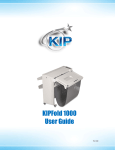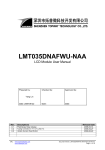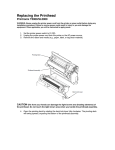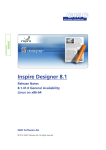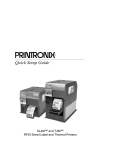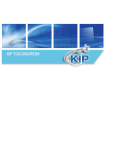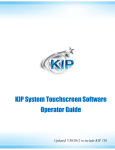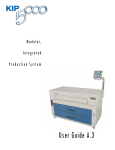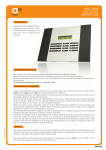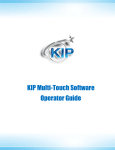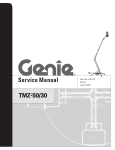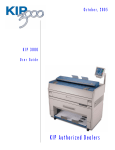Download GPIO Module User`s Manual
Transcript
General Purpose Input/Output (GPIO) Module Programmer’s Reference Manual Thermal Series Printers Product Warranty Printronix warrants that the Products furnished under this Agreement shall be free from defects in material and workmanship for a period of one year from the date of shipment from the Printronix facility. This warranty is applicable only if the products have had normal utilization within the published specifications as modified from time to time, have been maintained in accordance with recommended procedures with Printronix approved parts, and have not been modified or altered in a manner not approved by Printronix. For printers sold within the area in which Purchaser normally provides field service: For all printers the Purchaser will provide the end-user with a 90-day on-site warranty. Any printer or part therein found defective within one year of original shipping date from a Printronix facility shall be returned to Printronix and be repaired or replaced at the option and expense of Printronix. Purchaser shall pay shipping cost to the Printronix facility and Printronix will return the item(s) at its expense. For printers sold outside the area, within the Continental United States, in which Purchaser normally provides field service: Any printer found defective within 90 days from the date of shipment to the end user will be repaired at the end user’s location. If the end user is located within 100 miles of an Authorized Service Provider’s location, warranty service will be performed at no charge. If the end user is located more than 100 miles from an Authorized Service Provider’s location, travel time and expenses in excess of 100 miles will be billed to the end user at current rates or the printer may be shipped to the nearest Authorized Service Center for repair. If the end user elects to ship the printer for warranty repair, the end user shall pay the shipping cost to the Authorized Service Center and the printer will be returned at Printronix’ expense. The Products may be equipped with a general purpose input/output circuit board and corresponding pin connection (GPIO) which allow the Purchaser’s or end user’s printer to function as a controller in a computer system. Printronix publishes the specifications associated with GPIO and the pin connection and warrants that the printer’s input and output parameters at the pin connection conform to those specifications. Except as expressly warranted, GPIO is sold on an “as is” basis. There are no other warranties whatsoever, express or implied, concerning GPIO. Purchaser’s remedies are expressly limited to Printronix’ obligations as stated above, and in no event shall Printronix be held liable for any incidental or consequential damages or loss of use, or other commercial loss, however occasioned. THE WARRANTIES SET FORTH IN THIS ARTICLE AND THE OBLIGATIONS AND LIABILITIES THEREUNDER ARE IN LIEU OF, AND THE PURCHASER HEREBY WAIVES, ALL IMPLIED GUARANTEES AND WARRANTIES, INCLUDING WITHOUT LIMITATION, ANY WARRANTY OF MERCHANTIBILITY OR FITNESS FOR A PARTICULAR PURPOSE. IN NO EVENT SHALL PRINTRONIX BE HELD LIABLE FOR ANY INCIDENTAL OR CONSEQUENTIAL DAMAGES OR LOSS OF USE, OR OTHER COMMERICAL LOSS, HOWEVER OCCASIONED. Notice of Copyright This document contains proprietary information protected by copyright. No part of this document may be reproduced, copied, translated, or incorporated in any other material in any form or by any means, whether manual, graphic, electronic, mechanical, or otherwise, without the written consent of Printronix, Inc. All non-Printronix registered and/or unregistered trademarks used throughout this manual are the sole property of their respective owners. Copyright © 2003, 2013, 2015 Printronix, Inc. All rights reserved. Table of Contents GPIO............................................................................... 7 Overview .............................................................................................................. 7 Upgrading from T5000 to T8000 ......................................................................... 7 Panel keys..................................................................................................... 7 Panel messages ........................................................................................... 7 Menu Overview ................................................................................................... 8 GPIO Menu Descriptions ..................................................................................... 9 Connector Pinout ............................................................................................... 13 Signal Descriptions ............................................................................................ 14 Outputs........................................................................................................ 14 Inputs .......................................................................................................... 15 Power and Grounds .................................................................................... 16 Hardware Specifications .................................................................................... 16 Pre-Programmed Inputs for Use with Printer Menus .................................. 16 Pre-Programmed Outputs for Use with Printer Menus ............................... 16 External Power Outputs .............................................................................. 16 Compatibility ............................................................................................... 16 Electrical...................................................................................................... 16 Inputs And Outputs - Electrical ..................................... 19 GPIO Opto-coupled Input Circuit....................................................................... 19 GPIO Opto-coupled Output Circuit .................................................................... 19 Contact Information ...................................................... 21 Printronix Supplies Department .................................................................. 21 Corporate Offices ........................................................................................ 22 GPIO Overview The Printronix General Purpose Input/Output (GPIO) module is an optional accessory for thermal printers. It enables the printers to interface with an external device such as a label applicator system. Simple printer menus allow for programming three of the eleven pre-defined interface signals (seven outputs, four inputs) to select particular polarity or logic functions that can meet practically all typical print/apply requirements or be compatible with practically all the features available on other manufacturers’ external I/O interfaces. This allows easy migration of Printronix thermal and line matrix printers to new or existing systems. Field interface is accomplished through an industry standard 50-pin D-type connector. GPIO is available as a factory option or field installable kit that also includes a mating connector for field interface, installation instructions, and operation manual. Although there are seven pre-defined outputs and four pre-defined inputs, the GPIO module actually contains a total of eight inputs, eight outputs (all inputs and outputs are optically-isolated), and four relays. By using Printronix GPIO Manager software, these can all be custom configured and be mapped in conjunction with Printronix proprietary functions such as ODV analyses, printer front panel keys, and communications ports to provide powerful functions, including multiple interfaces, previously not attainable with a single accessory module. Upgrading from T5000 to T8000 The T8000 GPIO board is a new design, but the connections on the 50-pin connector are the same. The T8000 is backwards compatible with T5000 regarding number of I/O’s and the supported events and actions. However, to use an existing T5000 GPIO application on a T8000, some changes need to be made to the GPIO table: First, install the latest version of PrintNet Enterprise Suite (version 4.01L or later). Run the PrintNet Enterprise Suite application and open the GPIO Manager. Set the printer model to T8 under File > GPIO Configuration > Printer Model. Panel keys Due to the differences in the front panel, events that relate to the panel keys will be highlighted in the table after you’ve changed the model number to T8. This indicates that these entries need to be changed to use a proper key value. As the T8000 has a different set of keys (e.g. the addition of the two soft keys) you need to redesign your solution to use the keys that are appropriate. Panel messages When displaying GPIO messages on the T5000, the existing message on the 2x16 character LCD display will be replaced. As the T8000 has a larger display and uses smaller fonts, GPIO messages will now be shown in a dedicated area on the online screen, still allowing displaying all other information like status, printer name etc. When the printer is offline, the GPIO messages will be shown in a pop-up box. To prevent annoying popups, it is recommended to design your GPIO solution in a way that messages are only shown when the printer is online. 7 Menu Overview The GPIO menu is located under the System icon as shown in Figure 1 below. This submenu is only present if either the GPIO option is installed and/or a user defined table. The figure shows the available menus along with the defaults. System Control ... Printer Mgmt GPIO. *= Default Setting Tables Select Bank * Disable * 01 Apply Overstrike XYZ Status Port * Disable * Serial Select Table Start Print End Print * Table 01 * Input Low * Mode 1 Monitor Control Status Print & Apply * Disable * Input OFF * Data Ready Figure 1 GPIO Menu Overview IMPORTANT 8 XYZ Status Port menu for reference only. This is a proprietary feature not available with the standard GPIO product. GPIO Menu Descriptions System > GPIO > Tables Allows you to select a mapping table. Disable The GPIO is not active. Enable The user-defined mapping table. Internal The standard internal mapping table. User Defined Factory Default IMPORTANT The user-defined mapping table. This option appears only if a user-defined table is downloaded to the printer Disable On Print & Apply machines, set GPIO Tables to Disable to avoid unexpected tamp motion during printer configuration. After all configurations are complete, set Tables to Enable. System > GPIO > Select Bank Allows you to select a bank of tables. Minimum 01 Maximum 08 (since the maximum number of tables is 64) Range Factory Default IMPORTANT The range is from 01 to X, where X is the total number of defined tables (see Select Table menu) divided by eight, rounded up to the next whole number (e.g., 15 tables = 2 banks). 01 This menu appears only if Tables is set to “Enable” or “User Defined”. 9 System > GPIO > Select Table Allows you to select a table. This menu appears only if Tables is set to “Enable” or “User Defined”. Minimum Table 01 Maximum Table 64 The range depends on the number of defined tables (maximum 64) and the GPIO Select Bank setting. See Table 1. Range Factory Default IMPORTANT Table 01 This menu appears only if Tables is set to “Enable” or “User Defined”. Table 1 GPIO Sel. Table Range GPIO Select Bank Setting GPIO Sel. Table Range 01 01 to 08 02 09 to 16 03 17 to 24 04 25 to 32 05 33 to 40 06 41 to 48 07 49 to 56 08 57 to 64 System > GPIO > Start Print Start print logic. Input Low Start print when input asserts low. Input High Start print when input asserts high. Factory Default IMPORTANT 10 Input Low This menu appears only if Tables is set to “Internal”. System > GPIO > End Print End print logic. Mode 1 Normally high. Low only when a label is being moved forward. Mode 2 Normally low; high only when a label is being moved forward. Mode 3 Normally high; low for 50 milliseconds when a label has been printed and positioned. Always high during continuous printing modes. Mode 4 Normally low; high for 50 milliseconds when a label has been printed and positioned. Always low during continuous printing modes. Mode 5 Normally high. When the label has been printed completely, a low going, 50 millisecond pulse is sent. (This mode shows the end of a label print cycle, even in batch mode where labels are continuously being printed.). Mode 6 Identical to Mode 5, except normally low with a high going 50 millisecond pulse. Mode 7 Normally high. At the beginning of a label being printed, the output is set low. When the label is completed, the signal goes high. If another label has started printing, the signal stays high for 50 milliseconds. (This mode shows start and end of a label print cycle, even in batch mode where labels are continuously printed.). Mode 8 Identical to Mode 7, except normally low with high going signal. Factory Default Mode 1 IMPORTANT This menu appears only if Tables is set to “Internal”. IMPORTANT End print applies only to printed labels. Output remains in normal state for blank labels. 11 System > GPIO > Control Status Start print logic. This menu appears only for thermal printers, and only if Tables is set to “Internal”. Data Ready Low when sufficient data has been received to begin printing the next label. High whenever printing is stopped after the current label due to any condition causing the printer to pause or in the absence of a label format. Offline Low whenever the printer is offline. High whenever the printer is able to receive command streams and print labels. Factory Default IMPORTANT Data Ready This menu appears only if Tables is set to “Internal”. System > GPIO > Monitor Shows the status of the GPIO input opto-couplers on the control panel LCD. A ‘.’ (dot) indicates that the corresponding opto-coupler is inactive. A ‘|’ (bar) indicates the opto-coupler is active. Input OFF Start print when input asserts low. Input ON Start print when input asserts high. Factory Default IMPORTANT Input OFF This menu appears only if Tables is set to “Enable”, “Internal”, or “User Defined”. System > GPIO > Print&Apply Enables the use of print and apply hardware. Disable Print & Apply mode disabled. Enable Print & Apply mode enabled. Factory Default 12 Disable System > GPIO > XYZ Status Port This menu is for reference only and not available with the standard product. Disable Feature disabled. E-NET Data Port Serial Data sent out the Ethernet designated data port. Data sent out the serial port. Data sent out the Ethernet designated status port. E-Net Stat Port USB Data sent out the USB port. IEEE 1284 Data sent out the IEEE-1284 port. Factory Default Serial System > GPIO > Apply Overstrike This menu is used when Print&Apply is set to “Enable”. Disable RFID or verifier overstrike labels are not applied to boxes. Enable RFID or verifier overstrike labels are applied to boxes like passing labels. Factory Default Disable Connector Pinout The Printronix GPIO feature uses a 50-pin DIN connector to interface to Label Applicators, Programmable Logic Controllers, and the like. Using the printer resident pre-programmed I/O mapping tables, a number of connector pins are each assigned a specific function as listed in the table below. See “Signal Descriptions” on page 14 for a complete description these functions. INPUT OPTO‐COUPLER CONNECTOR PINS 1 Reprint Last Label 1 (anode) 9 (cathode) 2 Start Print 2 (anode) 10 (cathode) 3 Feed 3 (anode) 11 (cathode) 4 Pause 4 (anode) 12 (cathode) 5 to 8 Not Used 5 to 8 (anode) 13 to 16 (cathode) 13 OUTPUT OPTO‐COUPLER CONNECTOR PINS 1 Ribbon Low 18 (collector) 26 (emitter) 2 Ribbon Out 19 (collector) 27 (emitter) 3 Media Out 20 (collector) 28 (emitter) 4 Service Required 21 (collector) 29 (emitter) 5 End Print 22 (collector) 30 (emitter) 6 Control Status 23 (collector) 31 (emitter) 7 Not Used 24 (collector) 32 (emitter) 8 Power On 25 (collector) 33 (emitter) Signal Descriptions Outputs Ribbon Low Normally high, goes low when ribbon remaining is about 50 meters. The menu Media > Ribbon > Ribbon Low can be set to “Disable” or “Enable.” If “Disable” is selected, the GPIO signal is disabled. Stays low when ribbon is out. Ribbon Out Normally high. Low during a Ribbon Out condition. Media Out (Label Out) Normally high. Low during a Label Out condition. Error (Service Required) Normally high. Goes low whenever the printer is stopped for a fault condition that requires the user to perform an action to start again. This can be head open, or any operation fault condition, etc. End Print Logic programmable via printer menu. Mode 1. The default. Normally high. Low only when a label is being moved forward. Mode 2. Normally low; high only when a label is being moved forward. Mode 3. Normally high; low for 50 milliseconds when a label has been printed and positioned. Always high during continuous printing modes. Mode 4. Normally low; high for 50 milliseconds when a label has been printed and positioned. Always low during continuous printing modes. Mode 5. Normally high. When the label has been printed completely, a low going, 50 millisecond pulse is sent. (This mode shows the end of a label print cycle, even in batch mode where labels are continuously being printed.) Mode 6. Identical to Mode 5, except normally low with a high going 50 millisecond pulse. 14 Mode 7. Normally high. At the beginning of a label being printed, the output is set low. When the label is completed, the signal goes high. If another label has started printing, the high signal stays high for 50 milliseconds. (This mode shows start and end of a label print cycle, even in batch mode where labels are continuously printed.) Mode 8. Identical to Mode 7, except normally low with high going signal. NOTE: End Print applies only to printed labels. Output remains in normal state for blank labels. Data Ready/Off Line Programmable via printer menu. Ready Mode. The default. Low when sufficient data has been received to begin printing the next label. High whenever printing is stopped after the current label due to any condition causing the printer to pause or in the absence of a label format. Off Line Mode. Low whenever the printer is offline. High whenever the printer is able to receive command streams and print labels. Power On Low when valid power is applied to printer, i.e., the main CPU is operating. During power off, this should be in a high impedance state so an external device can pull up to a voltage. Inputs Reprint When low going edge is detected, the printer reprints the last label printed prior to receiving the signal. Only one label is reprinted. The signal must toggle high then low again to reprint another label. Start Print Signal polarity selectable via printer menu. Active Low. The default. When low, the printer will print one label. If still low at the end of the label, another label will be printed without delay. If high, the printer will not print. If the signal goes high while the printer is printing a label, printing will continue until the label has completed. The printer will stop and obey any other settings for end of label control such as eject, feed a particular distance, etc. Active High. Identical to Mode 1 except opposite polarity. A high input will print one label, etc. Feed If low, will feed a blank label (or labels) until a high input is detected. A high input stops the feeding of blank labels, and last blank label fed will stop at top-of-form. This signal has the lowest priority over other functions. If the printer is printing, ODV is voiding, or there are any error conditions, the signal is ignored. NOTE: This signal also has lower priority than Start Print. Pause When a signal toggles from high to low, it causes the printer to go into pause as if the PAUSE key were pressed. If a signal goes low during an operation, it will be treated the same way as if the PAUSE key were pressed, i.e., the label will finish if one was being printed, etc. This condition can only be reset by pressing the PAUSE key or by a similar command from a host if you have created one. 15 The signal must toggle high then low again to achieve another valid pause input. Power and Grounds +24 VDC 24 VDC Return (Ground) + 5 VDC 5 VDC Return (Ground) Frame Ground Hardware Specifications This section is a quick reference to the GPIO connections available when using the printer resident preprogrammed I/O mapping tables as well as the electrical specifications of the components used and the voltages available. See page 19 for a schematic diagram. Pre-Programmed Inputs for Use with Printer Menus Start Print (Polarity programmable via printer menu); input 2 Pause; input 4 Feed; input 3 Reprint; input 1 Not used; inputs 5, 6, 7, 8 Pre-Programmed Outputs for Use with Printer Menus End Print (8 modes via printer menu); output 5 Data Ready/Online (programmable via printer menu); output 6 Ribbon Low; output 1 Ribbon Out; output 2 Error - Service Required; output 4 Media Out; output 3 Power On; output 8 Not used; output 7 External Power Outputs +5VDC (.5 A fused) +24VDC (.25 A fused) – not available if cutter installed Two DC ground pins Compatibility GPIO is compatible with all accessories except wireless communication options. Electrical Inputs (eight total) Opto-isolated, separate anode and cathode pins per input Input voltage range (steady state); 5-10 VDC Series resistor; 4700 ohm, .25W Resistor through hole mounted; changeable with common techniques Outputs (eight total) 16 Opto-isolated, NPN transistor, separate collector and emitter pins per output Open collector output, NPN transistor Current – 300 ma maximum 70 VDC collector to emitter voltage maximum. Relays (four total) Each relay has three pins connected to the 50 pin connector: COM, NC and NO. Contacts are electrically isolated from the printer electronics. WARNING For safety reasons voltage should be limited to 42 volts DC max. 17 Printronix Expansion Bus Control Logic All anode protection resistors are 4.7K Ohms. Figure 2 Basic GPIO Schematic Diagram 18 Inputs And Outputs Electrical GPIO Opto-coupled Input Circuit Opto-coupler + 470 Ohm Input voltage range 5.35 VDC - GPIO Opto-coupled Output Circuit Pin 17 + Opto-coupler Active Low Output Factory Installed jumpers + Current Limited Output Load Factory Default Configuration User Selectable Configurations 19 20 Contact Information Printronix Customer Support Center IMPORTANT Please have the following information available prior to calling the Printronix Customer Support Center: • • • • Model number • • • Is the problem with a new install or an existing printer? Serial number (located on the back of the printer) Installed options (i.e., interface and host type if applicable to the problem) Configuration printout: (See “Printing A Configuration” ) in your printers Administrator’s manual. Description of the problem (be specific) Good and bad samples that clearly show the problem (faxing or emailing of these samples may be required) Americas (714) 368-2686 Europe, Middle East, and Africa (31) 24 6489 311 Asia Pacific (65) 6548 4114 China (86) 800-999-6836 http://www.printronix.com/support.aspx Printronix Supplies Department Contact the Printronix Supplies Department for genuine Printronix supplies. Americas (800) 733-1900 Europe, Middle East, and Africa (33) 1 46 25 19 07 Asia Pacific (65) 6548 4116 or (65) 6548 4132 China (86) 400-886-5598 India (800) 102-7869 http://www.printronix.com/supplies-parts.aspx 21 Corporate Offices Printronix, Inc. 15345 Barranca Parkway Irvine, CA 92618 U.S.A. Phone: (714) 368-2300 Fax: (714) 368-2600 Printronix Inc. c/o Printronix Nederland BV Bijsterhuizen 11-38 6546 AS Nijmegen The Netherlands Phone: (31) 24 6489489 Fax: (31) 24 6489499 Printronix Schweiz GmbH 42 Changi South Street 1 Changi South Industrial Estate Singapore 486763 Phone: (65) 6542 0110 Fax: (65) 6546 1588 Printronix Commercial (Shanghai) Co. Ltd 22F, Eton Building East No.555, Pudong Av. Shanghai City, 200120, P R China Phone: (86) 400 886 5598 Fax: (86-21) 5138 0564 Visit the Printronix web site at www.printronix.com 258786-001 A 22






















